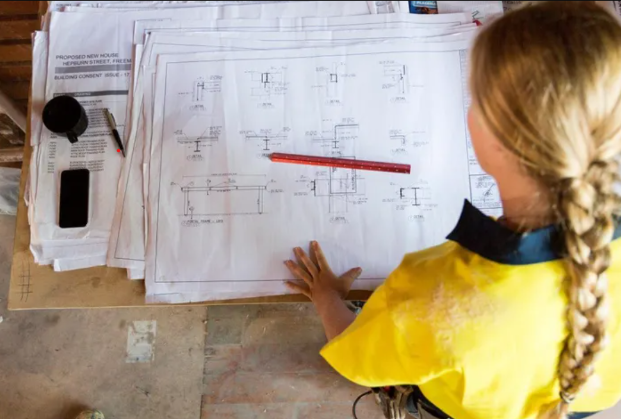Women’s Unique Contributions to the Trade Field

Many women are now opting for trade schools instead of traditional universities to pursue careers in male-dominated fields. This trend is driven by various factors, including economic considerations, high-demand job opportunities, increased awareness of gender equality, skills gap, flexibility, and career satisfaction.
Though gaining attention recently, this trend isn’t new and has been supported by diversity and inclusivity initiatives that help break down stereotypes.
Choosing the Right Trade
The rise in female tradies isn’t random. On the contrary!
Many women look for better benefits and job prospects by making use of labor shortages and rising industry demands. Selecting the right trade is the first step in this process, and it should be done with careful planning for the future.
After all, “trade” is an umbrella term that brings together carpentry, welding, plumbing, electrical work, masonry, and many other diverse callings.
That’s why women in the trade field looking for a new career path should ask themselves the following questions at the very least:
- Do I enjoy hands-on work?
If yes, suitable careers include: carpentry, plumbing, electrical work, and HVAC technicians.
- Do I have mechanical skills?
If yes, suitable careers include: welding, auto mechanics, and machinists.
- Do I enjoy design and creativity?
If yes, suitable careers include: landscaping, horticulture, and interior design.
- Do I enjoy outdoor work?
If yes, suitable careers include: roofing, masonry, and landscaping.
- Do I prefer indoor work?
If yes, suitable careers include: cabinetmaking, electronics technicians, and HVAC technicians.
- Do I want a steady workflow?
If yes, suitable careers include: HVAC technicians, plumbers, electricians, and welders.
- Do I enjoy problem-solving?
If yes, suitable careers include: Maintenance technicians and industrial maintenance.
Assessing individual skills and strengths realistically is crucial when picking a career path.
Apprenticeships and Pre-Apprenticeship Programs
Women in skilled trades aiming to become powerful leaders should explore education opportunities in their chosen fields.
For starters, they need to build practical skills and accumulate experience. For this, there are apprenticeships and pre-apprenticeship programs.
These typically take the shape of either hands-on learning, structured training (classroom instruction and on-the-job training), mentorship, or industry certification.
Pre-apprenticeship programs offer core skills training, an introduction to trades, soft skill development, career path guidance, and job placement assistance.
Understanding Trade Industry Diversity
Women in skilled trades can build impressive careers if they choose their calling wisely. Namely, the trade industry offers a wide range of niches, each with specific skill requirements and specializations that can lead to higher-paying careers.
E.g., carpentry branches into residential, commercial, and industrial sectors, allowing for individualism and creativity.
However, in addition to picking a suitable trade, women tradies should also make an effort to understand the demand for specific trades in the target region.
Keep in mind that economic development and regional infrastructure projects influence local demand. E.g., areas with strong economic development might need industrial maintenance and HVAC technicians, while regions with significant energy sectors may require welders and electricians.
Setting Long-Term Goals in the Trades
Women tradies should consider long-term career goals, as each trade offers different opportunities for advancement. Various specializations can lead to becoming a master tradeswoman, project manager, teacher, or mentor. Examples of career progression include:
- Becoming a master plumber by earning journeyman status and passing the master plumber’s exam
- Specializing in historic restoration
- Project management roles in overseeing long-term projects
- Pursuing teaching certifications in trades
Dealing With Stereotypes
While success stories keep emerging, it’s fair to say that women tradies still face challenges in male-dominated fields. Biases and stereotypes persist even though they’re abating.
That’s why it is highly recommended for women starting out to connect with successful women tradies and seek their guidance. Much can be learned from their experience, so don’t skip this step.
Typical barriers that women tradies face include stereotypes, lack of representation, inadequate access to resources, and workplace discrimination.
Stereotypes about women’s capabilities in physical and technical roles discourage many women from considering these career paths. The perception that trade jobs are “men’s work” can be a significant deterrent.
Nevertheless, times are looking up. Increased visibility of successful women tradies is likely to help dismantle these stereotypes in the future. For the time being, showcasing role models and sharing their stories can inspire more women to enter and succeed in these fields.
Secure Resources
Access to resources such as mentorship programs, training opportunities, and financial aid is crucial for women entering trades.
In this regard, mentorship programs can come in extremely handy. Mentors can provide guidance, and support, and introduce women to professionals who can help them learn the ropes of traditionally male-dominated industries.
These efforts can lead to obtaining scholarships and financial aid specifically allocated for women in trades.
Overall, even though there are many challenges to keep in mind for women tradies, the opportunities are growing by the minute. Employers are addressing barriers thanks to inclusivity initiatives, so don’t be scared to pursue your dreams.



